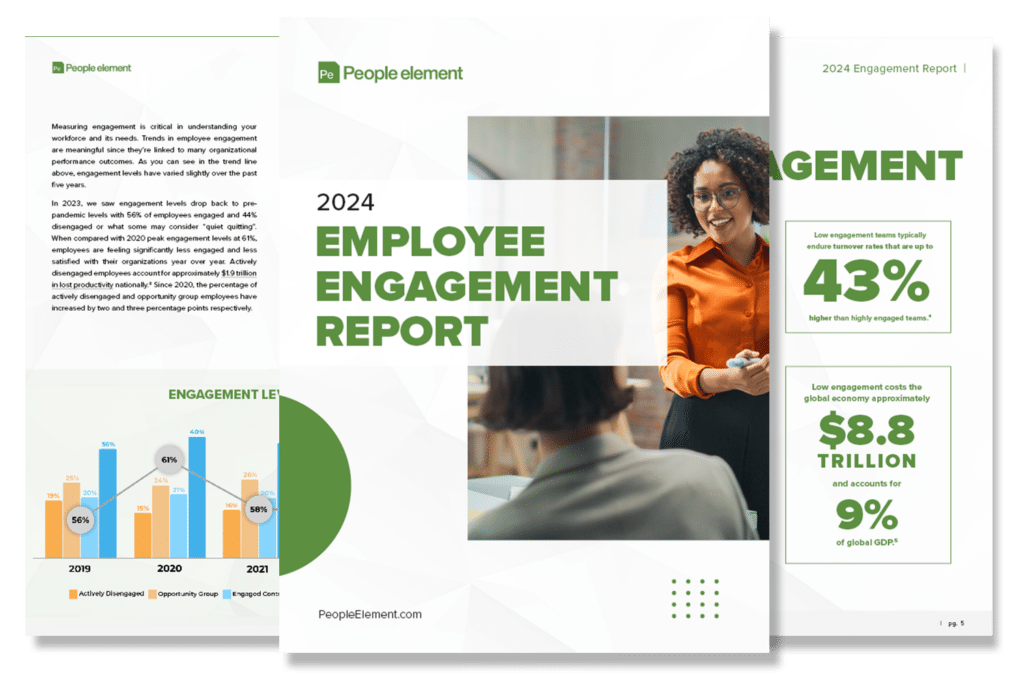Savvy HR leaders know that employee engagement starts during onboarding.
For a personal glimpse into a negative onboarding experience, take this story from a People Element team member about a past job:
They don’t include the second “real job” they had on their resume. They’d worked there for five days when they turned in their resignation. They couldn’t wait to get out the door.
Since then they’ve spent more than 10 years working in the world of talent management and human resources. They now understand that they played a role in why they didn’t succeed in that job – they were new to the professional world and rather than speak up or communicate their concerns, they left.
But they now have some perspective about several organizational issues that contributed to their quick departure:
- They didn’t have a manager,
- “New employee orientation” consisted of a binder with a printed, 500-page document, and
- Not one person checked in to see what they needed to succeed
In the end, it was a lose-lose situation: they was looking for a new job. And, the organization lost time and money with their unnecessary turnover.
New Hire 30 day Check In
This scenario would have ended differently if they’d had the opportunity to complete a new hire check-in survey. Many studies indicate that the first three months are the most important in a new job. There are many ways to increase comfort level and productivity for new employees during this time. One of those ways is by conducting a new hire check-in, ideally handled by a third party.
A third-party new hire check-in allows an organization to:
- Collect information and data about challenges that new hires experience
- Demonstrate that the organization values employee input
- Establish the expectation that employees speak up about issues in their work environment
People Element works with organizations to analyze turnover data and identify the right time for a new hire check-in. For some organizations a new hire check-in takes place 30 days after hire, others conduct new hire check-ins at 45 days, 60 days, 90 days, or in some cases, all of the above. And, based on any turnover trends identified, the initial check-in might even occur the first week a new hire is on the job.
By using a third-party to conduct new hire check-ins, companies see higher participation rates, better quality of data, and deeper levels of feedback. Employees are more likely to provide honest feedback when they aren’t worried about who will see their – potentially unfavorable – responses to survey questions.
When companies don’t make the time to conduct new hire check-ins, they run the risk of losing those employees due to unclear expectations, miscommunication, lower morale, and bad decisions. Ultimately, organizations face financial loss due to high turnover of new hires.
Reduce early turnover with an Employee Onboarding Survey
New hire feedback via a check-in provides valuable information by helping uncover perception gaps and serving to engage employees. All of these factors can have a positive impact on reducing early turnover.
In our story, if the employee had any inkling that someone in the organization was invested in their success, they might have stayed. If the employee had a chance to provide feedback about the less-than-ideal work situation, it might have given them hope that things would change. And, while their perceptions may have been skewed, without a new hire check-in, the organization didn’t have any idea what their negative perceptions were.
Asking for new hire feedback is an important part of reducing turnover, but the real power lies in what you do with that information. After you’ve gathered data from new hire check-in surveys, you must communicate with employees regarding:
- Positive and negative trends identified in the survey
- Tactical steps you’re taking to resolve any issues, and
- Progress updates about the changes
Employees want to provide feedback. But in order to remain engaged with your organization, they also need to hear and see the results their feedback delivers.
Increase long-term retention
When you implement new hire check-ins, you’re setting up a solid foundation for your employees to thrive in your organization. People Element consistently finds that new hires who complete a check-in survey are more satisfied across all aspects of their work experience.
This initial check-in paves the way for those new hires to eventually become your longest tenure employees. Taking action to answer – and act on – the feedback employees provide through check-in surveys demonstrates that you’re listening and making changes based on employee input.
The improvements you make based on new hire check-in surveys will ultimately benefit your entire employee population.
Retain the right talent with the right new hire check in questions
New hire check-in data can be used throughout the employee lifecycle to help maintain an employee’s initial and long-term engagement with your organization. The data you gather in these surveys can also serve as a powerful tool when it comes to making important hiring decisions.
When reviewing responses to new hire check-in questions, you’re able to create a profile of successful new hires that assists managers with not only delivering a great employment experience but also helps the organization understand and identify, the best candidates.
Why should you use Employee Onboarding Surveys?
During the first three months of employment, many new hires are still trying to decide if they’re going to stay with your organization. New hire check-in surveys provide data about the challenges employees face, but these check-ins also demonstrate that your organization cares about your employees, that you value their input, and that you’re committed to creating a positive work experience.
Whether it’s at five days, 30 days, 60 days or 90 days, offering new hires an opportunity to provide real feedback about their experience goes a long way to retaining your most valued employees. By demonstrating your commitment to their success, chances are your new hires will proudly be including their tenure with your company on their resume for years to come.





